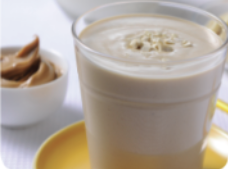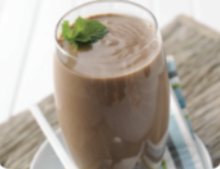Smoothies are one of those foods that have stayed popular and remained on the food trend list for the last few years. Everywhere you look; restaurants, recipe books, food blogs and Pinterest are filled with the most delicious smoothie recipes and a simple google search on smoothies can pull through pages and pages of articles and recipes, but needless to say, looking through all this information can be a pretty daunting task. For those of you who don’t know anything about smoothies…you are in luck, here is all the information you need to know about making a nutritious smoothie.
WHAT ARE THEY?
A smoothie is a blended drink made from a combination of fruits and/or vegetables; a liquid such as milk, a milk alternative, yogurt or juice and ice.1 Smoothies can vary in thickness depending on the ratio of solid to liquid ingredients used.
WHY ARE THEY A GREAT ADDITION TO YOUR DAY?
As smoothies contain a combination of foods, they are a great way to boost your nutrition in one meal. They often contain beneficial vitamins, minerals, antioxidants, fibre as well as healthy fats and protein. Smoothies are versatile and if made correctly they can be had as a meal, snack or healthy treat. There are endless combinations of ingredients that you can use to make smoothies, therefore it’s difficult to get bored. Smoothies are also quick and easy to prepare, just put all the ingredients into a blender and ‘whala’ you have a nutrient dense meal.
ARE SMOOTHIES SAFE FOR INDIVIDUALS LIVING WITH DIABETES?
Living with diabetes doesn’t mean you need to deny yourself all the foods you love, but it is still important to ensure that you make healthier food choices. As smoothies contain many ingredients, they can often be high in sugar, carbohydrates and calories which can cause havoc on blood sugar levels. Therefore it’s important to choose your ingredients carefully and keep an eye on how much you drink at a time.
HOW TO MAKE A ‘DIABETIC-FRIENDLY’ SMOOTHIE
- Choose your produce
Most smoothie recipes call for the addition of a selection of fruits. Fruits are high in vitamins, minerals, fibre, antioxidants and natural sugars. Any seasonal fruit of your choice can be used but make sure include fruits of different colours. Examples include all berries, apples, pear, melon, nectarine, citrus, kiwi and plums etc. Watch your portion of the following fruit as they contain more sugar per portion e.g. banana’s, grapes, figs, paw paw, melon and dried fruit.
If you are going to include other carbohydrate sources in your smoothie, such as dairy or a cereal product e.g. FUTURELIFE® or oats, it is suggested you only include 1/2 - 1 fruit portion per smoothie.
One fruit portion = 1 tennis ball size fruit OR 2 golf ball size fruit OR ½ cup
People often forget about adding vegetables to smoothies. Vegetables also contain fewer carbohydrates than fruit therefore are helpful in keeping the total carbohydrate of the smoothie down. Including vegetables in your smoothie is a quick and convenient way to include more vegetables into your day. Any of the green vegetables such as kale, spinach, broccoli, cucumber and avocado are great additions to any smoothie as they contain little carbohydrates. Be careful of starchy vegetables such as carrots or beetroot. Some recipes also call for cooked vegetables like sweet potato or legumes that contribute to fibre content, texture and taste.
One vegetable portion = 1 cup raw vegetables OR ½ cup cooked
Natural sugars, found in fruits and starchy vegetables, also cause spikes in your blood sugar levels if too much is eaten at once. Remember to count the fruit and starchy vegetables you blend into your smoothies as part of your daily fruit allowance. This will ensure you don’t overdo it on carbohydrates.
- Add your liquid
There are many choices when it comes to liquids, many people just add water or ice. Including plain, unsweetened dairy such yoghurt or milk not only contributes calcium and vitamin D which is important for bone health but also increases the protein content. This helps to lower the Glycaemic index (GI) of the whole smoothie (refer to article on GI & GL),2 which helps to prevent spikes in blood sugar levels.2,3 Bear in mind that dairy also contains carbohydrates, therefore contributing to the total carbohydrate content of the smoothie.
For dairy free options include a non-sweetened milk alternative such as soy, almond, rice, hemp, or a little bit of coconut milk. Other recipes also call for fruit juice, however for people living with diabetes, fruit juice isn’t recommended as it contains natural sugars but no fibre. Remember these smoothies contain multiple ingredients that contain carbohydrates, fruit juice will push the carbohydrate content up quickly.
- Boost nutrition
Protein & Fat
Including a source of protein and fat in your smoothie is helpful as they both slow the rate at which the meal leaves the stomach. This slows down the absorption of the sugars into your blood which prevents spikes in blood sugar levels.
- Ways to boost the protein content would be to add a protein powder such as whey and /or casein which is milk based or a plant based protein powder include hemp, soy, brown rice, and pea.
- Include the following healthy fats in your smoothie: 1 small handful of nuts, 1 - 2 Tablespoons of seeds, ½ small avocado (gives your smoothie a creamy texture), 1 tablespoon of sugar free nut butter and 1 teaspoon of seed oils e.g. coconut, flaxseed, macadamia or olive.
Other tips:
- Whole grains can also be a useful addition to the smoothie as they contribute texture and boost the nutritionals by adding vitamins, minerals, fibre, and protein and are low GI. Oats or oat bran are a great option. Remember to watch portions as they will contribute to the carbohydrate content
- Don’t add extra sweeteners; remember fruits and dairy contain natural sugars already.
- Remember to consider the carbohydrate content of the total smoothie. This should be no more than 1 – 3 carbohydrate exchanges depending on if it’s a meal or snack.
WHERE DOES FUTURELIFE® FIT IN?
FUTURELIFE® products are a great addition to any smoothie as they contain nutrients that are useful when looking at the steps for making diabetic friendly recipes above. They are high in protein, fibre, healthy fats and omega-3. Many of our products are also enriched with vitamins and minerals; contain the prebiotic inulin and MODUCARE® which supports the immune system. Our products are also quick and easy to prepare, just add water or milk.
FUTURELIFE® HIGH PROTEIN Smart food™ and ZERO Smart food™ are the recommended products to add to any smoothie. FUTURELIFE® HIGH PROTEIN Smart food™ has the highest protein content of 30 g per 100g, contains SmartProtein3D™ which is a combination of soy, casein and whey protein, and has the lowest carbohydrate content of all our products.
FUTURELIFE® ZERO Smart food™ contains no added cane sugar and contains FUTURELIFE® Smart Sweetness instead which is a combination of Stevia, Erthryitol and Sucralose.
HOW TO MAKE A DIABETIC FRIENDLY SMOOTHIE:
- Choose your produce. Include both fruit and vegetables and stick to portions
- One fruit portion = 1 tennis ball size fruit OR 2 golf ball size fruit OR ½ cup
- One vegetable portion = 1 cup raw vegetables OR ½ cup cooked
- Add your liquid e.g. water, milk, yoghurt or dairy free option such as unsweetened soy, almond or coconut milk
- Boost the nutritionals with a source of protein and fat
- Consider the carbohydrate content of the total smoothie
There you have it, see how simple it is to make your own smoothie. Remember by following these principles above you can adapt any smoothie recipe into one that is suitable for people living with diabetes. Included below are some easy recipes containing FUTURELIFE® products for those living with diabetes. Consult with your dietitian or diabetic nurse educator if you have any questions or visit www.futurelife.com for more information on any of our products or diabetic meal plans.
FUTURELIFE® Peanut Butter Protein Blitz Smoothie
1 cup of low fat / fat free milk
1 tablespoon. sugar free, salt free peanut butter (or any sugar free nut butter)
1 handful of ice cubes
50g FUTURELIFE® original HIGH PROTEIN Smart food™
Method
Place all ingredients into a blender and blend for 30 seconds.

FUTURELIFE® Mocha Protein Smoothie
½ cup coffee, already prepared
½ cup of vanilla fat free / low fat yoghurt
1 tablespoon sugar free, salt free peanut butter (or any sugar free nut butter)
1 handful of ice cubes
50g FUTURELIFE® original HIGH PROTEIN Smart food™
Method
Place all ingredients into a blender and blend for 30 seconds.

FUTURELIFE® Peanut Butter Protein Blitz Smoothie
1/3 cup mixed frozen berries
125 ml plain fat free / low fat yoghurt
125 ml water
40 g or 4 Tbsp. FUTURELIFE® ZERO Smart food™ or 50g FUTURELIFE® HIGH PROTEIN Smart food™
1 cup of ice
5 g fresh mint
Method
Place all ingredients into a blender and blend for 30 seconds.
FUTURELIFE® Peanut Butter Protein Blitz Smoothie
1 passion fruit or granadilla
125 ml plain low fat / fat free milk
125 ml water
40 g or 4 Tbsp. FUTURELIFE® ZERO Smart food™
Method
Place all ingredients into a blender and blend for 30 seconds.

REFERENCES:
- http://www.diabetesselfmanagement.com/blog/smoothies-and-diabetes-do-the-two-mix/
- Basics of GI & GL by Ashleigh Smith, Futurelife Dietitian
- http://www.diabetes.org/food-and-fitness/food/what-can-i-eat/understanding-carbohydrates/glycemic-index-and-diabetes.html?referrer=https://www.google.co.za/
- https://www.healthysmoothiehq.com/diabetic-smoothies
Author: FUTURELIIFE® Dietitian



